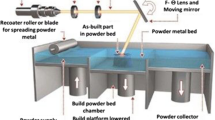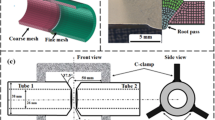Abstract
Flow forming is used to produce thin-walled high-precision tubular components. A 3D thermo-mechanical finite element model for staggered backward flow forming of a cylindrical workpiece of maraging steel has been developed using Abaqus/Explicit. The effect of tip radius of the rollers and friction between the rollers and the workpiece has been considered. Simulations have been carried out at different process conditions to study the state variables, such as stresses and strains obtained during the deformation. The model has been benchmarked for thickness reduction and roll forces against the experimental results and analytical solutions, respectively. The effect of flow forming process variables, such as feed rate and reduction ratio, on the stress/strain distribution and roll forces have been studied. An increase in feed rate from 1 to 2.33 mm/s leads to an increase of 7 % in effective plastic stress. An increase of 72 % in equivalent plastic strain has been observed when the reduction ratio is increased from 23 to 33 %. In addition, a parametric study has been conducted to study ovality, diametral growth, roll forces, stresses, and strains as a function of process parameters. The circularity of the tube is a very important geometrical feature in the flow forming process. It is imperative to study the key parameters affecting the circularity of the preform. Eight process variables have been considered in a response-surface-based computer design of experiments to minimize the ovality. The feed rate, reduction ratio, and the attack angle of the roller Z are found to be most significant parameters in order to control the circularity of the tube. Among all process variables, the reduction ratio is found to be the most significant parameter. The order of their relative significance is reduction ratio, feed rate, and the attack angle of the roller Z.
Similar content being viewed by others
References
Hayama M (1966) Theoretical study of tube spinning. Bull JSME 15:33–47
Hayama M, Kudo H (1979) Experimental study of tube spinning. Bull JSME 22:769–775
Kobayashi S, Thomsen EG (1962) Theory of spin forging. CIRP Ann 10:114–123
Park JW, Kim YH, Bae WB (1997) Analysis of tube-spinning processes by the upper-bound stream-function method. J Mater Process Technol 66:195–203
Kim N, Kim H, Jin K (2013) Minimizing the axial force and the material build-up in the tube flow forming process. Int J Precis Eng Manuf 14(2):259–266
Molladavoudi HR, Djavanroodi F (2010) Experimental study of thickness reduction effects on mechanical properties and spinning accuracy of aluminum 7075-O, during flow forming. Int J Adv Manuf Technol 52(9–12):949–957
Venkateshwarlu GGG, Ramesh Kumar K, Janardhan Reddy TA (2013) Study on the mechanism of force calculations in flow forming: a review. Int J Adv Res Eng Technol 4(3):194–201
Parsa MH, Pazooki AMA, Nili Ahmadabadi M (2008) Flow-forming and flow formability simulation. Int J Adv Manuf Technol 42(5–6):463–473
Li Y, Wang J, Lu G-D, Chen Q-S (2012) Three-dimensional finite element analysis of effects of roller intervals on tool forces and wall thickness in stagger spinning of thin-walled tube. Proc Inst Mech Eng C J Mech Eng Sci 227(7):1429–1440
Hua FA, Yang YS, Zhang YN, Guo MH, Guo DY, Tong WH, Hu ZQ (2005) Three-dimensional finite element analysis of tube spinning. J Mater Process Technol 168:68–74
Mohebbi MS, Akbarzadeh A (2010) Experimental study and FEM analysis of redundant strains in flow forming of tubes. J Mater Process Technol 210:389–395
Song X, Fong KS, Oon SR, Tiong WR, Li PF, Korsunsky AM, Danno A (2013) Diametrical growth in the forward flow forming process: simulation, validation and prediction. Int J Adv Manuf Technol 71(1–4):207–217
Aghchai AJ, Razani NA, Dariani BM (2012) Flow forming optimization based on diametral growth using finite element method and response surface methodology. J Eng Manuf 10(24):1–11
Abaqus Analysis User’s Manual (2003) ABAQUS Inc. Version 6.4.
Jakus A, Fredenburg A, Thadhani N (2012) High-strain-rate behavior of maraging steel linear cellular alloys: mechanical deformations. Mater Sci Eng 534:452–458
Huang L, Yang H, Zhan M (2008) 3D-FE modeling method of splitting spinning. Comput Mater Sci 42(4):643–652. doi:10.1016/j.commatsci.2007.09.012
Xu Y, Zhang SH, Li P, Yang K, Shan DB, Lu Y (2001) 3D rigid-plastic FEM numerical simulation on tube spinning. J Mater Process Technol 113:710–713
Xia QX, Cheng XQ, Hu Y, Ruan F (2006) Finite element simulation and experimental investigation on the forming forces of 3D non-axisymmetrical tubes spinning. Int J Mech Sci 48(7):726–735. doi:10.1016/j.ijmecsci.2006.01.014
Gur M, Tirosh J (1982) Plastic flow instability under compressive loading during shear spinning process. J Eng Ind Trans ASME 1982(104):17–22
Author information
Authors and Affiliations
Corresponding author
Rights and permissions
About this article
Cite this article
Shinde, H., Mahajan, P., Singh, A.K. et al. Process modeling and optimization of the staggered backward flow forming process of maraging steel via finite element simulations. Int J Adv Manuf Technol 87, 1851–1864 (2016). https://doi.org/10.1007/s00170-016-8559-7
Received:
Accepted:
Published:
Issue Date:
DOI: https://doi.org/10.1007/s00170-016-8559-7




